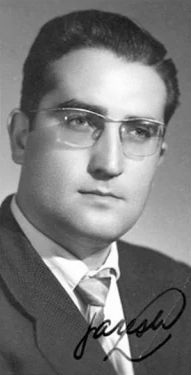Gabriel Aresti facts for kids
Quick facts for kids
Gabriel Aresti Segurola
|
|
|---|---|
 |
|
| Born | October 14, 1933 Bilbao, Biscay, Basque Country, Spain |
| Died | 5 June 1975 (aged 41) Bilbao, Biscay, Basque Country, Spain |
| Occupation | Poet, writer |
Gabriel Aresti Segurola (born October 14, 1933 – died June 5, 1975) was a very important writer and poet from the Basque Country. He wrote many famous works in the Basque language during the 20th century.
Contents
Who Was Gabriel Aresti?
Gabriel Aresti was a key figure in Basque literature. He helped shape modern writing in the Basque language. He was known for his strong opinions and his dedication to his culture.
Early Life and Learning Basque
Gabriel Aresti grew up in Bilbao, a city where most people spoke Spanish. Even though his grandparents spoke Basque, Gabriel did not learn it as his first language. He taught himself Basque when he was older. By the age of 21, he was already writing for magazines.
His Important Books and Writings
Gabriel Aresti's first major work was Maldan Behera (meaning Downhill). Later, he wrote some of his most famous books. These include Harri eta Herri (Stone and Country, 1964), Euskal Harria (The Basque Stone, 1968), and Harrizko Herri Hau (This Country of Stone, 1971). These books often talked about society and everyday life.
He also wrote in other styles, like novels, short stories, and plays. Gabriel Aresti was also a talented translator. He translated works by famous writers such as Federico García Lorca, T. S. Eliot, and Giovanni Boccaccio into Basque.
A Champion for Basque Culture
Gabriel Aresti was known for being very direct and sometimes controversial. He wrote many articles that caused him problems. He faced challenges not only from the government at the time (led by Francisco Franco) but also from some traditional Basque groups. This was because of his ideas about social fairness and equality.
He was a big inspiration for modern Basque culture. He believed in using everyday language and popular culture in his writing. He did not agree with those who wanted to make the language too "pure." As a member of the Euskaltzaindia (the Academy of the Basque Language), he strongly supported a unified Basque language. He even used this unified language in his writing before the academy officially adopted it in 1968.
Helping New Writers
Gabriel Aresti also played a big role in helping other writers. He started a publishing company called Lur. This company allowed new authors who wrote in Basque to publish their first books. Some of these new writers included Ramon Saizarbitoria, Arantxa Urretabizkaia, and Xabier Lete.
See also
 In Spanish: Gabriel Aresti para niños
In Spanish: Gabriel Aresti para niños

